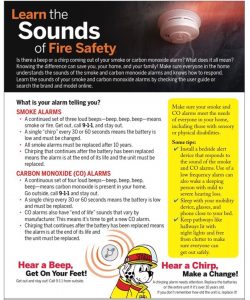National Fire Prevention Week Focuses On Family Safety
 ***Guest Blog by John Garrigan, security professional***
***Guest Blog by John Garrigan, security professional***
October 3rd through the 9th is National Fire Prevention Week and commemorates the great Chicago fire that took place on that date in 1871. Here are some seemingly basic behaviors can have life-saving impact.
Fire departments in the US respond to a house fire every 86 seconds
Smoke Detector = Life Saver
- The majority of fire-related deaths that occur in the home are due to either a smoke detector not working or where a smoke detector was not installed at all.
Half of home fire deaths result from fires reported between 11 p.m. and 7 a.m.
Practice Fire Safety
There are time-tested ways to prevent and survive a fire. It’s not a question of luck. It’s a matter of practicing and planning ahead.
- Space Heaters Need Space – Keep portable space heaters at least 3 feet from paper, curtains, furniture, clothing, bedding, or any thing else that can burn. Never leave heaters on when you leave home or go to bed, and keep children and pets well away from them.
- Have a Home Evacuation Plan – If fire breaks out in your home, you must get out fast. With your family, plan two ways out of every room. Fire escape routes must not include elevators, which might take you right to the fire! Choose a meeting place outside where everyone should gather. Once you are out, stay out! Have the whole family practice the escape plan at least twice a year.
- Cool a Burn – If someone gets burned, immediately place the wound in cool water for 10 to 15 minutes to ease the pain. Do not use butter on a burn, as this could prolong the heat and further damage the skin. If burn blisters or chars, see a doctor immediately.
One-quarter of home fire deaths were caused by fires that started in the bedroom. Another quarter resulted from fires in the living room, family room or den.
Crawl Low Under Smoke
If you encounter smoke using your primary exit, use your alternate route instead. If you must exit through smoke, clean air will be several inches off the floor. Get down on your hands and knees, and crawl to the nearest safe exit.
- Stop, Drop, and Roll – Every one should know this rule: if your clothes catch fire, don’t run! Stop where you are, drop to the ground, and roll over and over to smother the flames.
- Cover your face with your hands to protect your face and lungs.
Three out of five home fire deaths happen from fires in homes with no smoke alarms or no working smoke alarms.
Practice Candle Safety
The popularity of candles as home decorations in recent years, has resulted in an increase of candle related fires. Some safe tips include:
- Never leave a lit candle unattended in any room of the house
- Never leave candles burning when you go to bed; and never use candles near combustible materials such as curtains, drapes, bedding and cabinets.
Cooking equipment is the leading cause of home fire injuries, followed by heating equipment.
How to Use A Fire Extinguisher
It’s always a good idea to keep one or two fire extinguishers in your home. In the event you need to use one…just P.A.S.S. it!!!
- Pull the pin out in a twisting motion
- Aim the nozzle at the base of the fire in front of you
- Squeeze the handle
- Sweep from side to side
If you need to use one, first call 911. Only use an extinguisher on a small fire and never place you between the fire and an exit. Never put yourself in danger and never place a used extinguisher back in place.
Additional Resources:
- www.cdc.gov
- www.firesafeftytips.com
- www.nfpa.org
About John Garrigan: John is an accomplished and highly respected security professional with over 35 years of leadership in contract security, corporate security, risk management, training, and public safety. He has served as administrative assistant to the Boston Police commissioner and held senior executive positions in some of the largest security companies in the US and the private sector. Early in his career, he developed a wide range of public safety improvement programs for a variety of US cities, including Atlanta, and the US government. John has been intimately involved in helping to establish high value strategic public-private partnerships between the public safety and private business/security sectors.








